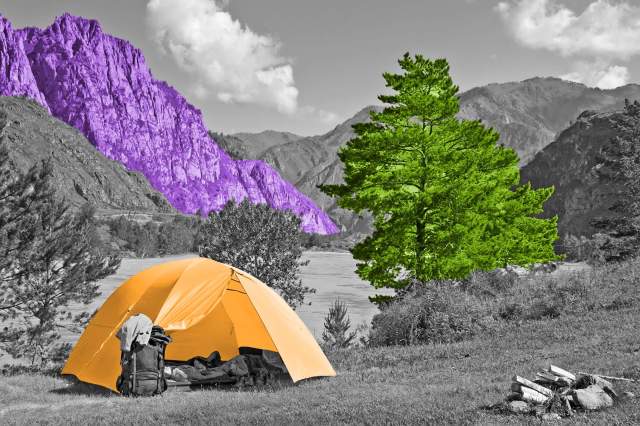
The Civil War Helped Popularize Camping in the U.S.
For Union and Confederate soldiers, camping wasn’t the fun activity we consider it today — it was a necessity of the conflict. Troop movements required soldiers on both sides to move long distances, carrying everything they needed to eat and sleep until they reached their next encampment (one possible origin for the word “camping”). While many Civil War conscripts did settle for longer periods of time in cabins and forts (especially during the freezing winter months), camping was a common occurrence.
At the time, sleeping under the stars wasn’t seen as glamorous, but that changed after the war’s end. In the years following the Civil War, camping slowly transformed from being a primitive military necessity to a romanticized activity. According to historian Phoebe S. K. Young, the idea of sitting around a campfire with friends, just like soldiers had, was one way the country tried to reframe the war’s impact during the tumultuous time of reconstruction. (In other words, maybe parts of the war hadn’t been that bad, or so the idea went.) Campers of the later Victorian era set off into nature to test their survival skills, looking to get away from the creature comforts of (then) modern society, and promoting camping as a vacation from the rigidity of daily life — an idea that’s stuck around ever since.

Early Sleeping Bags Had a Different Name
Bed rolls and other camp bedding have been around as long as humans have been trying to get comfortable z’s while dozing on the ground; some of the oldest surviving sleep sacks were made from warm animal hides. But in 1876, Welsh inventor Pryce Jones rolled out his version of the sleeping bag, which most closely resembles the ones we pack on our camping trips today. It had a different name, though: the Euklisia Rug.
Made from wool, the Euklisia Rug was essentially a blanket that could be folded over its occupant and fastened closed to keep them warm; the original design even included a pocket for an inflatable pillow. Jones’ invention was initially picked up by the Russian army, which bought his design in bulk; 60,000 of his so-called rugs were purchased for troops during the Russo-Turkish War, though not all would be delivered. The inventor was stuck with 17,000 after Russia canceled its order during the conflict. He sold them through his mail-order business, which helped the product catch on.

The First RVs Appeared in 1910
Just two years after Henry Ford unveiled his Model T car, eager outdoor enthusiasts were looking for ways their automobiles could get them out into nature, and sleep there, too. In 1910, Pierce-Arrow’s Touring Landau debuted in Madison Square Garden, complete with many of the amenities modern recreational vehicles have today. The Touring Landau featured a foldable back seat that transformed into a bed, a sink that folded from the chauffeur’s seat, a telephone to communicate with the driver, and a toilet. The car wouldn’t be the last of its kind; by 1915, New York inventor Roland R. Conklin rolled out his upgraded version, a bus that could hold 11 people and had a shower, a kitchen, and a hidden bookcase (although the vehicle was for his personal use only).
RV manufacturers continued expanding the portable campers, adding more of the comforts of home through the late 1920s, until the Great Depression led RV sales to drop. (However, some savvy Americans turned the campers into inexpensive mobile homes.) By World War II, RVs became the framework for mobile hospitals and other forms of war effort transportation, though they eventually returned to their original purpose — camping and vacationing — in the 1950s and beyond.
More Interesting Reads

You Can Thank Girl Scouts for S’mores
S’mores are the stuff of culinary legend — almost everyone enjoys them, but hardly anyone knows how they became so popular. Turns out the gooey, chocolatey treat dates back to around the 1920s, when they were called “Some-mores.” One of the first s’mores recipes appeared in 1927’s Tramping and Trailing with the Girl Scouts, a scouting guide that instructed brigades of campers on how to set up camp, hike safely, and build fires (a necessity for melting marshmallows). By the 1970s, Girl Scout manuals updated the name to the shortened “s’mores,” arguably a bit easier to say with a mouth full of sticky dessert. In the decades since, s’mores have become traditional campground fare, even honored with their own holiday on August 10.

Seven Principles Can Help You Be a Superb Camper
Most hikers and outdoor explorers head outside for a chance to reconnect with nature, an experience that can be restoring and enjoyable. Unfortunately, the impact of humans on our natural world can sometimes dampen the adventure. That’s the motivation behind Leave No Trace, an outreach program that works to preserve natural spaces by educating the public about minimizing our recreational footprint. Emerging around the 1960s and ’70s when backpacking and camping boomed in popularity, Leave No Trace introduced seven principles, supported by national parks and other conservation groups, that help keep landscapes pristine and enjoyable for all. Most of the guidelines now seem like no-brainers: Properly dispose of trash where it belongs, respect wildlife by giving animals space, and plan ahead for your outdoor adventure to stay safe, for example. But the list of outdoor ethics also provides tips for keeping campfires forest-friendly and picking the perfect campsite without disturbing local flora and waterways. Familiarizing yourself with the long-standing outdoor code can help make your time at camp more enjoyable — now, and for years to come.












